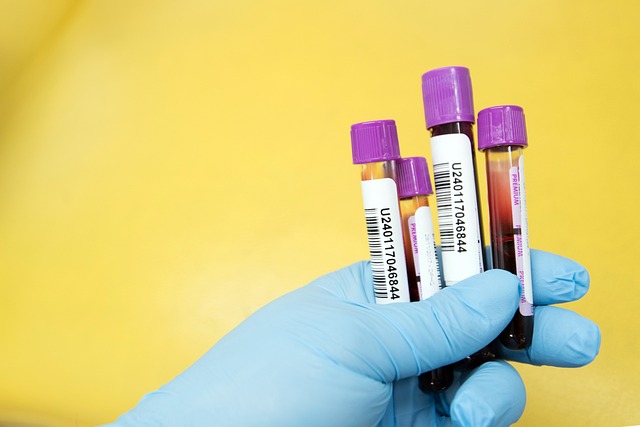The UK Standard Liver Blood Test is an essential diagnostic procedure for assessing liver health. It includes measurements of alanine aminotransferase (ALT), aspartate aminotransferase (AST), gamma-glutamyl transferase (GGT), alkaline phosphatase (ALP), and total bilirubin. These biomarkers collectively offer insights into the liver's function, with abnormal levels that might indicate liver disease or injury. The test is a first step in diagnosis, helping medical practitioners determine if further examination is needed. ALT and AST often point to hepatocellular injury, GGT can suggest cholestasis issues, while bilirubin levels are indicative of the liver's waste management capabilities. When combined with imaging techniques like ultrasounds, these tests provide a comprehensive view of liver health, enabling accurate diagnoses and personalized treatment plans. This approach is crucial for managing chronic liver diseases and ensuring timely and effective medical care, with regular monitoring facilitating early intervention for conditions such as cirrhosis and hepatitis.
The UK Standard Liver Blood Test serves as an indispensable diagnostic tool for medical professionals, offering insightful data on hepatic health. This article delves into the nuances of this test, crucial for early detection and management of liver disorders. We will explore its components, clinical significance, and the intricacies involved in interpreting its results effectively within clinical practice. Understanding the test’s parameters is essential for healthcare providers to accurately assess liver function and guide treatment decisions, thereby improving patient outcomes.
- Understanding the UK Standard Liver Blood Test: An Overview for Medical Professionals
- Components of the UK Standard Liver Blood Test and Their Clinical Significance
Understanding the UK Standard Liver Blood Test: An Overview for Medical Professionals

The UK Standard Liver Blood Test is a crucial diagnostic tool for medical professionals in assessing hepatic function and identifying potential liver pathologies. This standardized panel typically includes five key tests: alanine aminotransferase (ALT), aspartate aminotransferase (AST), gamma-glutamyl transferase (GGT), alkaline phosphatase (ALP), and total bilirubin. These enzymes and substances are indicators of liver health; elevated levels can signal liver dysfunction, inflammation, or damage. The test provides an initial screening for liver issues and guides further investigation when abnormalities are detected. For instance, ALT and AST are markers of hepatocellular injury, GGT often correlates with cholestasis, and bilirubin levels reflect the liver’s capacity to process waste products from blood. Understanding the nuances of these components is essential for accurate interpretation and effective patient management. Medical professionals must consider the clinical context, patient history, and other relevant tests when evaluating the results of a UK Standard Liver Blood Test to arrive at a precise diagnosis and treatment plan. Additionally, these tests are often used in conjunction with imaging studies like ultrasounds to provide a comprehensive evaluation of liver health. This integrated approach ensures a thorough understanding of the patient’s condition and facilitates timely and appropriate medical intervention.

The UK Standard Liver Blood Test is a pivotal diagnostic tool utilized by medical professionals to assess liver health. This comprehensive panel includes key indicators such as Alanine aminotransferase (ALT), Aspartate aminotransferase (AST), Alkaline phosphatase (ALP), Gamma-glutamyl transferase (GGT), and Total Bilirubin. These markers provide insight into the liver’s functionality by detecting abnormalities that could signify hepatocellular injury, biliary obstruction, or cholestasis. The test is a non-invasive procedure, offering an initial step in evaluating liver function and guiding subsequent diagnostic actions when abnormal results are observed. It is a critical component in the early detection of liver disease, enabling timely intervention and management to improve patient outcomes. For healthcare providers in the UK, understanding the nuances of this standardized test is essential for accurate diagnosis and effective patient care within the realm of hepatic disorders. Regular monitoring of these liver function tests allows for the tracking of liver health over time, aiding in the management of chronic conditions such as liver cirrhosis and hepatitis.
Components of the UK Standard Liver Blood Test and Their Clinical Significance

The UK Standard Liver Blood Test is a crucial diagnostic tool for medical professionals, providing a comprehensive overview of liver health through a panel of components. This test includes measurements of serum bilirubin, alanine aminotransferase (ALT), aspartate aminotransferase (AST), alkaline phosphatase (ALP), and gamma-glutamyl transferase (GGT). Serum bilirubin levels are indicative of the liver’s ability to process bile pigments; elevated levels can signal hemolysis, hepatic dysfunction, or obstructive jaundice. Alanine aminotransferase and aspartate aminotransferase, collectively known as SGPT/SGOT, are enzymes predominantly found in the liver; their increased activity in the blood can indicate liver cell injury due to hepatitis, drug toxicity, or other liver diseases. Alkaline phosphatine is an enzyme present in the liver, bile ducts, and bone; its levels can rise in conditions such as cholestasis, cirrhosis, and certain bone disorders. Gamma-glutamyl transferase, found in the liver and pancreas, is a marker for liver disease, particularly alcoholic liver disease, cholestasis, or bile duct obstruction. The interpretation of these tests requires clinical acumen to correlate with patient history, symptoms, and other investigations, ensuring accurate diagnosis and timely initiation of appropriate treatment. Medical professionals rely on the UK Standard Liver Blood Test to detect early signs of liver dysfunction, monitor disease progression, and evaluate the effectiveness of interventions, making it an indispensable part of liver health assessment in a clinical setting.
In conclusion, the UK Standard Liver Blood Test serves as an invaluable diagnostic tool for medical professionals. By comprehending its components—albumin, alanine aminotransferase (ALT), aspartate aminotransferase (AST), alkaline phosphatase (ALP), gamma-glutamyl transferase (GGT), total bilirubin, and prothrombin time or international normalized ratio (INR)—practitioners can effectively assess liver function and identify potential hepatic disorders. The test’s utility in early detection and management of liver conditions underscores its importance in clinical practice, particularly within the UK healthcare system. Medical professionals are encouraged to utilize this standardized approach to enhance patient care and outcomes, ensuring timely and accurate diagnoses for liver-related ailments.
